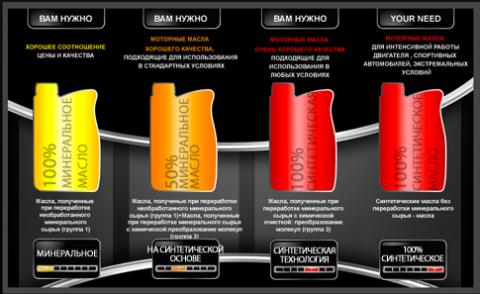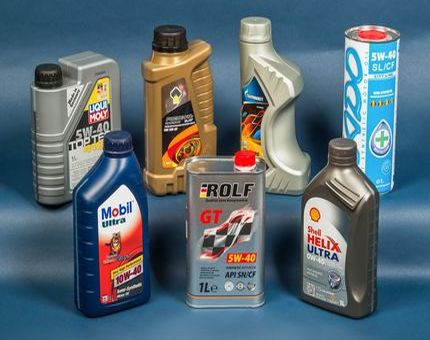
What is synthetic oil
Content
Synthetic oil is a synthesis of base oils based on synthetics, as well as additives that give it useful properties (increased wear resistance, cleanliness, corrosion protection). Such oils are suitable for operation in the most modern internal combustion engines and in extreme operating conditions (low and high temperatures, high pressure, etc.).
Synthetic oil, unlike mineral oil, produced on the basis of targeted chemical synthesis. In the process of its production, crude oil, which is the basic element, is distilled, and then processed into basic molecules. further, based on them, base oil is obtained, to which additives are added so that the final product has exceptional characteristics.
Properties of synthetic oil
Graph of oil viscosity versus mileage
A feature of synthetic oil is that it retains its properties for a long time. After all, they are also set at the stage of chemical synthesis. In its process, "directed" molecules are created, which provide them.
The properties of synthetic oils include:
- high thermal and oxidative stability;
- high viscosity index;
- high performance at low temperatures;
- low volatility;
- low coefficient of friction.
These properties determine the advantages that synthetic oils have over semi-synthetics and mineral oils.
Benefits of Synthetic Motor Oil
Based on the above properties, we will consider what advantages synthetic oil gives the car owner.
Distinctive properties of synthetic oil | <font><font>Materials</font></font> | Advantages |
High viscosity index | Optimal oil film thickness at both low and high temperatures | Reduced wear of internal combustion engine parts, especially under extreme temperatures |
Low temperature performance | Preservation of fluidity when starting the internal combustion engine in conditions of extremely low temperatures | Fastest possible oil flow to important parts of the internal combustion engine, reducing wear at start-up |
Low volatility | Minimum oil consumption | Savings on oil refills |
Low friction coefficient | More uniform synthetic oil molecular structure, lower internal coefficient of friction | Improving the efficiency of the internal combustion engine, reducing the oil temperature |
Enhanced thermal-oxidative properties | Slowing down the aging process of oil in contact with oxygen molecules | Stable viscosity-temperature characteristics, minimal formation of deposits and soot. |
Composition of synthetic oil
Synthetic motor or transmission oil consists of components of several classes:
- hydrocarbons (polyalphaolefins, alkylbenzenes);
- esters (reaction products of organic acids with alcohols).
Difference between mineral and synthetic oil molecules
Depending on the composition and conditions of chemical reactions, oils are divided into the following types - essential, hydrocarbon, polyorganosiloxane, polyalphaolefin, isoparaffin, halogen-substituted, chlorine- and fluorine-containing, polyalkylene glycol, and so on.
It is important to know that many manufacturers assign their oils the definition of synthetic conditionally. This is due to the fact that in some countries the sale of synthetics is tax free. In addition, oils obtained by hydrocracking are sometimes also referred to as synthetic. In some states, mixtures containing up to 30% additives are considered synthetic oils, in others - up to 50%. Many manufacturers simply buy base oils and additives from synthetic oil manufacturers. By mixing them, they get compositions that are sold in many countries of the world. thus, the number of brands and the actual synthetic oil is growing from year to year.
Viscosity and classification of synthetic oil
Viscosity - This is the ability of the oil to remain on the surface of the parts, and at the same time maintain fluidity. The lower the viscosity of the oil, the thinner the oil film. It is characterized viscosity index, which indirectly indicates the degree of purity of the base oil from impurities. Synthetic motor oils have a viscosity index value in the range of 120 ... 150.
Typically, synthetic motor oils are made using base stocks that have the best low temperature properties, and belonging to a wide range of viscosity grades. For example, SAE 0W-40, 5W-40 and even 10W-60.
To indicate the viscosity grade, use SAE standard - American Association of Mechanical Engineers. This classification gives the temperature range at which a particular oil can operate. The SAE J300 standard divides oils into 11 types, of which six are winter and five are summer.

How to choose the viscosity of engine oil
In accordance with this standard, the designation consists of two numbers and the letter W. For example, 5W-40. The first digit means the coefficient of low temperature viscosity:
- 0W - used at temperatures up to -35 ° C;
- 5W - used at temperatures up to -30 ° C;
- 10W - used at temperatures up to -25 ° C;
- 15W - used at temperatures up to -20 ° C;
The second number (in the example 40) is the viscosity when the internal combustion engine is heated. This is a number that characterizes the minimum and maximum viscosity of the oil at its temperature in the range of + 100 ° С ... + 150 ° С. The higher this number, the higher the viscosity of the car. For an explanation of other designations on a synthetic oil canister, see the article “Oil Marking”.
Recommendations for the selection of oils according to their viscosity:
- when developing an internal combustion engine resource up to 25% (new engine), you need to use oils with classes 5W-30 or 10W-30 all season;
- if the internal combustion engine has worked out 25 ... 75% of the resource - 10W-40, 15W-40 in summer, 5W-30 or 10W-30 in winter, SAE 5W-40 - all season;
- if the internal combustion engine has worked out more than 75% of its resource, then you need to use 15W-40 and 20W-50 in summer, 5W-40 and 10W-40 in winter, 5W-50 all season.
Is it possible to mix synthetic, semi-synthetic and mineral oils
We will immediately answer this question - mix any oils, even of the same type, but from different manufacturers highly not recommended. This fact is due to the fact that when mixing, chemical reactions between different additives are possible, the result of which is sometimes unpredictable. That is, the resulting mixture will not meet at least some norms or standards. Therefore, blending oils is the most last resort when there is no other option.
Temperature dependence of viscosity
Typically, mixing oils occurs when changing from one oil to another. Or in the case when you need to top up, but the necessary oil is not at hand. How bad is mixing for the internal combustion engine? And what to do in such cases?
Only oils from the same manufacturer are guaranteed to be compatible. After all, the technology for obtaining and the chemical composition of additives in this case will be the same. Therefore, when changing the oil also several workers, you will need to fill in the oil of the same brand. It is better to replace, for example, synthetic oil with mineral oil from one manufacturer than with another “synthetic” from another manufacturer. However, it is better to quickly get rid of the resulting mixture in the internal combustion engine as soon as possible. When changing the oil, about 5-10% of its volume remains in the internal combustion engine. Therefore, the next few cycles, oil changes should be carried out more often than usual.
In what cases it is necessary to flush the internal combustion engine:
- in case of replacement of the brand or manufacturer of oil;
- when there is a change in the characteristics of the oil (viscosity, type);
- in case of suspicion that an extraneous liquid has got into the internal combustion engine - antifreeze, fuel;
- there are suspicions that the oil used is of poor quality;
- after any repair, when the cylinder head was opened;
- in case of doubt that the last oil change was carried out long ago.
Reviews of synthetic oils
We bring to your attention a rating of brands of synthetic oils, which is compiled based on feedback from motorists and opinions of respected experts. Based on this information, you can make a decision about which synthetic oil is best.
TOP 5 best synthetic oils:
Specific Motul DEXOS2 5w30. Synthetic oil approved by General Motors. Differs in high quality, steady work in the conditions of high and low temperatures. Works with any kind of fuel.
| Positive reviews | Negative feedback |
| Additives work the entire regulatory period. Great replacement for GM oil. | I've been pouring GM DEXOC 2 oil, for seven years now and everything is fine, and your matul, promoted on the Internet, as one good person said shit |
| Really better than GM Dexos2, the internal combustion engine has become quieter and gasoline consumption has decreased. Yes, there is no more smell of burning, otherwise, after 2 tkm, the native GM smelled like some kind of palenka ... | |
| The general impressions are positive, the engine performance and the reduced fuel consumption and oil waste are especially pleasing. |
SHELL Helix HX8 5W/30. The oil is made according to a unique technology that allows you to actively clean the internal combustion engine parts from the accumulation of dirt and the formation of sediment on its nodes. Due to the low viscosity, fuel economy is ensured, as well as protection of the internal combustion engine between oil changes.
| Positive reviews | Negative feedback |
| I've been running it for 6 years now with no problems. I opened the internal combustion engine so oily varnish in a minimal amount on the walls of the internal combustion engine. In winter, at minus 30-35, it started up without problems | Lots of fake products. |
| Excellent coverage of the oil film of internal combustion engine parts. Good temperature range. Only+++ | Immediately, what I didn’t like was a HUGE expense for waste. driving 90% on the highway. And yes, the price is outrageous. Of the benefits — a confident start in the cold. |
| The oil performed very well. All properties written on the packaging are true. Can be changed every 10000 kilometers. | The price is high, but it's worth it |
Lukoil Lux 5W-40 SN/CF. Oil is produced on the territory of the Russian Federation. Approved by such well-known car manufacturers as Porsche, Renault, BMW, Volkswagen. The oil belongs to the premium class, therefore it can be used in the most modern gasoline and diesel turbocharged ICEs. commonly used for cars, vans and small trucks. also suitable for uprated ICE sports cars.
| Positive reviews | Negative feedback |
| I have a 1997 Toyota camry 3 liter, and I have been pouring this Lukoil Lux 5w-40 oil for 5 years. In winter, it starts from the remote control in any frost with half a turn | Thickens prematurely, promotes deposits |
| I must say right away that the oil is good, the price corresponds to the quality! In car services, of course, they try to sell expensive, European oil, etc. The more expensive it is, the higher the risk of taking a lining, this is a fact, unfortunately. | Rapid loss of properties. low protection of the internal combustion engine |
| I've been using it for many years, no complaints. Change somewhere every 8 - 000 kilometers. What is especially pleasing is that when taking at gas stations it is almost impossible to get a fake. | Ugar began to appear after 2000 km of run on it. It's such a good oil! |
TOTAL QUARTZ 9000 5W 40. Multigrade synthetic oil for petrol and diesel engines. also suitable for turbocharged engines, vehicles with catalytic converters and using leaded gasoline or LPG.
| Positive reviews | Negative feedback |
| The oil is really good, Total keeps the brand high. Has approvals from leading European manufacturers: Volkswagen AG, Mercedes-Benz, BMW, PSA Peugeot Citroën. | Driving test - Total Quartz 9000 Synthetic oil did not impress us with its results. |
| Drove it already 177'000, never upset me | The oil is nonsense, I personally made sure, I poured it into two cars, I also listened to the advice in Audi 80 and Nissan Almera, at high speeds this oil does not have any viscosity, both engines rattled, and I took oils in different specialized stores, so a bad delivery is excluded !! ! I do not advise anyone to pour this nonsense! |
| In addition to this oil, I haven’t poured anything and I’m not going to pour it! good quality from replacement to replacement, not a drop, in frost it starts up with half a turn, suitable for both gasoline and diesel vehicles! In my opinion, only a few can compete with this oil! | There is no certainty that I am not buying a fake - this is a basic problem. |
Castrol Edge 5W 30. Synthetic demi-season oil, can be used in both gasoline and diesel engines. because it has the following quality classes: A3/B3, A3/B4, ACEA C3. The manufacturer also promises better protection through the development of a reinforced oil film that forms on the parts. Provides for extended drain intervals of over 10 km.
| Positive reviews | Negative feedback |
| I’ve been driving Castrol 5w-30 for two years now, excellent oil after 15 thousand, the color even hardly changes, even when the car was running in, I didn’t add anything, enough from replacement to replacement. | I changed the car and already decided to pour it into the new car, drove away from the replacement and then I was negatively surprised, the oil was black and already smelled of burning. |
| Compared to the same Ford form that has been used for more than 3 years, the oil is more liquid. The internal combustion engine is quieter. Thrust returned and the sound of internal combustion engines characteristic of ff2. Chose by VIN | They poured it into the VW Polo, as it was recommended by the manufacturer. Oil is expensive, leaves carbon deposits in the internal combustion engine. the car is very loud. I don't understand why it costs so much |
How to distinguish synthetic oil
Although the viscosity of mineral, semi-synthetic and synthetic oils may be the same at certain temperatures, the performance of “synthetics” will always be better. Therefore, it is important to be able to distinguish oils by their type.
When buying synthetic oil, you must first of all pay attention to the information indicated on the canister. So, synthetic-based oils are designated by four terms:
- Synthetically Fortified. Such oils are synthetically fortified and have impurities of synthetic components up to 30%.
- Synthetic Based, Synthetic Technology. Similar to the previous one, however, the amount of synthetic components here is 50%.
- Semi-Synthetic. The amount of synthetic components is more than 50%.
- Fully Synthetic. It is 100% synthetic oil.
In addition, there are methods by which you can check the oil yourself:
- If you mix mineral oil and “synthetics”, the mixture will curdle. However, you need to know exactly what type the second oil belongs to.
- Mineral oil is always thicker and darker than synthetic oil. You can throw a metal ball into the oil. In the mineral, it will sink more slowly.
- Mineral oil is softer to the touch than synthetic oil.
Since synthetic oil has excellent characteristics, unfortunately, a large number of counterfeit products can be found on the market, because attackers are trying to cash in on its manufacture. Therefore, it is important to be able to distinguish the original oil from a fake.
How to distinguish a fake

How to distinguish the original engine oil from a fake. (shell helix ultra, Castrol Magnatec)
There are several simple ways to help you distinguish a canister or bottle of fake engine oil from the original:
- Carefully examine the lid and the quality of the occlusion. Some manufacturers install sealing antennae on the lid (for example, SHELL Helix). also, attackers can simply lightly glue the lid in order to arouse the suspicion of the original blockage.
- Pay attention to the quality of the lid and canister (jar). They should not have scuffs. After all, the most popular method of packaging counterfeit products is in containers purchased at service stations. Preferably, in order for you to know what the original cap looks like (the most popular brand of oil that is counterfeited is Castrol). If there is the slightest suspicion, check the entire body of the canister and, if necessary, refuse to purchase.
- The original label must be affixed evenly and look fresh and new. Check how well it is glued to the canister body.
- On any packaging container (bottles, canisters, iron cans) must be indicated factory batch number and date of manufacture (or the date until which the oil is serviceable).
Try to buy oil from trusted sellers and official representatives. Do not buy it from people or stores that are suspicious. This will save you and your car from possible problems.
